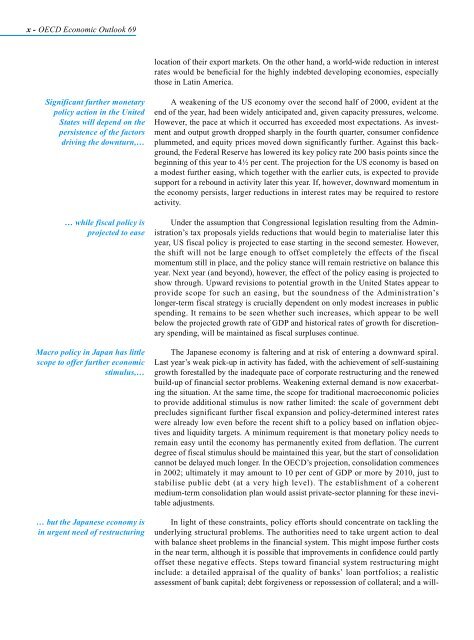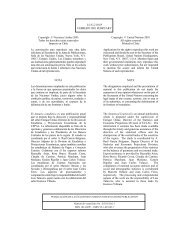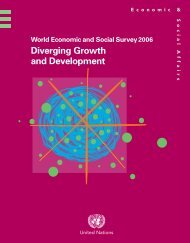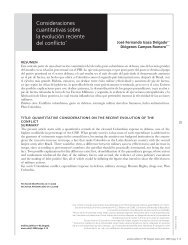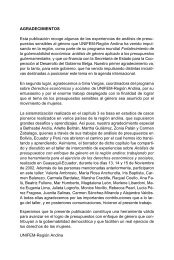OECD Economic Outlook 69 - Biblioteca Hegoa
OECD Economic Outlook 69 - Biblioteca Hegoa
OECD Economic Outlook 69 - Biblioteca Hegoa
You also want an ePaper? Increase the reach of your titles
YUMPU automatically turns print PDFs into web optimized ePapers that Google loves.
x - <strong>OECD</strong> <strong>Economic</strong> <strong>Outlook</strong> <strong>69</strong><br />
Significant further monetary<br />
policy action in the United<br />
States will depend on the<br />
persistence of the factors<br />
driving the downturn,…<br />
… while fiscal policy is<br />
projected to ease<br />
Macro policy in Japan has little<br />
scope to offer further economic<br />
stimulus,…<br />
… but the Japanese economy is<br />
in urgent need of restructuring<br />
location of their export markets. On the other hand, a world-wide reduction in interest<br />
rates would be beneficial for the highly indebted developing economies, especially<br />
those in Latin America.<br />
A weakening of the US economy over the second half of 2000, evident at the<br />
end of the year, had been widely anticipated and, given capacity pressures, welcome.<br />
However, the pace at which it occurred has exceeded most expectations. As investment<br />
and output growth dropped sharply in the fourth quarter, consumer confidence<br />
plummeted, and equity prices moved down significantly further. Against this background,<br />
the Federal Reserve has lowered its key policy rate 200 basis points since the<br />
beginning of this year to 4½ per cent. The projection for the US economy is based on<br />
a modest further easing, which together with the earlier cuts, is expected to provide<br />
support for a rebound in activity later this year. If, however, downward momentum in<br />
the economy persists, larger reductions in interest rates may be required to restore<br />
activity.<br />
Under the assumption that Congressional legislation resulting from the Administration’s<br />
tax proposals yields reductions that would begin to materialise later this<br />
year, US fiscal policy is projected to ease starting in the second semester. However,<br />
the shift will not be large enough to offset completely the effects of the fiscal<br />
momentum still in place, and the policy stance will remain restrictive on balance this<br />
year. Next year (and beyond), however, the effect of the policy easing is projected to<br />
show through. Upward revisions to potential growth in the United States appear to<br />
provide scope for such an easing, but the soundness of the Administration’s<br />
longer-term fiscal strategy is crucially dependent on only modest increases in public<br />
spending. It remains to be seen whether such increases, which appear to be well<br />
below the projected growth rate of GDP and historical rates of growth for discretionary<br />
spending, will be maintained as fiscal surpluses continue.<br />
The Japanese economy is faltering and at risk of entering a downward spiral.<br />
Last year’s weak pick-up in activity has faded, with the achievement of self-sustaining<br />
growth forestalled by the inadequate pace of corporate restructuring and the renewed<br />
build-up of financial sector problems. Weakening external demand is now exacerbating<br />
the situation. At the same time, the scope for traditional macroeconomic policies<br />
to provide additional stimulus is now rather limited: the scale of government debt<br />
precludes significant further fiscal expansion and policy-determined interest rates<br />
were already low even before the recent shift to a policy based on inflation objectives<br />
and liquidity targets. A minimum requirement is that monetary policy needs to<br />
remain easy until the economy has permanently exited from deflation. The current<br />
degree of fiscal stimulus should be maintained this year, but the start of consolidation<br />
cannot be delayed much longer. In the <strong>OECD</strong>’s projection, consolidation commences<br />
in 2002; ultimately it may amount to 10 per cent of GDP or more by 2010, just to<br />
stabilise public debt (at a very high level). The establishment of a coherent<br />
medium-term consolidation plan would assist private-sector planning for these inevitable<br />
adjustments.<br />
In light of these constraints, policy efforts should concentrate on tackling the<br />
underlying structural problems. The authorities need to take urgent action to deal<br />
with balance sheet problems in the financial system. This might impose further costs<br />
in the near term, although it is possible that improvements in confidence could partly<br />
offset these negative effects. Steps toward financial system restructuring might<br />
include: a detailed appraisal of the quality of banks’ loan portfolios; a realistic<br />
assessment of bank capital; debt forgiveness or repossession of collateral; and a will-


